
Prince Edward, Duke of Kent and Strathearn was the fourth son and fifth child of King George III and Queen Charlotte. His only child, Victoria, became Queen of the United Kingdom 17 years after his death.

Abraham Pineo Gesner, ONB was a Nova Scotian and New Brunswickan physician and geologist who invented kerosene. Gesner was born in Cornwallis, Nova Scotia and lived much of his life in Saint John, New Brunswick. He died in Halifax, Nova Scotia. He was an influential figure in the development of the study of Canadian geology and natural history.

The Chesapeake Affair was an international diplomatic incident that occurred during the American Civil War. On December 7, 1863, Confederate sympathizers from the Maritime Provinces captured the American steamer Chesapeake off the coast of Cape Cod. The expedition was planned and led by Vernon Guyon Locke (1827–1890) of Nova Scotia and John Clibbon Brain (1840–1906). When George Wade of New Brunswick killed one of the American crew, the Confederacy claimed its first fatality in New England waters.

The Old Burying Ground is a historic cemetery in Halifax, Nova Scotia, Canada. It is located at the intersection of Barrington Street and Spring Garden Road in Downtown Halifax.

By the arrangements of the Canadian federation, the Canadian monarchy operates in Nova Scotia as the core of the province's Westminster-style parliamentary democracy. As such, the Crown within Nova Scotia's jurisdiction is referred to as the Crown in Right of Nova Scotia, His Majesty in Right of Nova Scotia, or the King in Right of Nova Scotia. The Constitution Act, 1867, however, leaves many royal duties in the province specifically assigned to the sovereign's viceroy, the lieutenant governor of Nova Scotia, whose direct participation in governance is limited by the conventional stipulations of constitutional monarchy.

The history of Nova Scotia covers a period from thousands of years ago to the present day. Prior to European colonization, the lands encompassing present-day Nova Scotia were inhabited by the Mi'kmaq people. During the first 150 years of European settlement, the region was claimed by France and a colony formed, primarily made up of Catholic Acadians and Mi'kmaq. This time period involved six wars in which the Mi'kmaq along with the French and some Acadians resisted the British invasion of the region: the French and Indian Wars, Father Rale's War and Father Le Loutre's War. During Father Le Loutre's War, the capital was moved from Annapolis Royal, Nova Scotia, to the newly established Halifax, Nova Scotia (1749). The warfare ended with the Burying the Hatchet ceremony (1761). After the colonial wars, New England Planters and Foreign Protestants immigrated to Nova Scotia. After the American Revolution, Loyalists immigrated to the colony. During the nineteenth century, Nova Scotia became self-governing in 1848 and joined the Canadian Confederation in 1867.
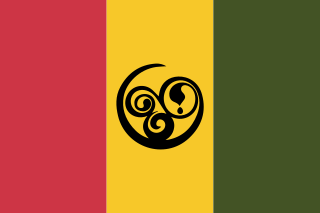
Black Nova Scotians are Black Canadians whose ancestors primarily date back to the Colonial United States as slaves or freemen, later arriving in Nova Scotia, Canada, during the 18th and early 19th centuries. As of the 2021 Census of Canada, 28,220 Black people live in Nova Scotia, most in Halifax. Since the 1950s, numerous Black Nova Scotians have migrated to Toronto for its larger range of opportunities. The first recorded free African person in Nova Scotia, Mathieu da Costa, a Mikmaq interpreter, was recorded among the founders of Port Royal in 1604. West Africans escaped slavery by coming to Nova Scotia in early British and French Colonies in the 17th and 18th centuries. Many came as enslaved people, primarily from the French West Indies to Nova Scotia during the founding of Louisbourg. The second major migration of people to Nova Scotia happened following the American Revolution, when the British evacuated thousands of slaves who had fled to their lines during the war. They were given freedom by the Crown if they joined British lines, and some 3,000 African Americans were resettled in Nova Scotia after the war, where they were known as Black Loyalists. There was also the forced migration of the Jamaican Maroons in 1796, although the British supported the desire of a third of the Loyalists and nearly all of the Maroons to establish Freetown in Sierra Leone four years later, where they formed the Sierra Leone Creole ethnic identity.
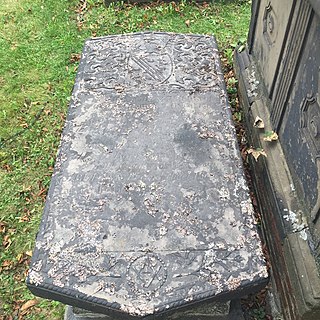
Winckworth Tonge was an Anglo-Irish soldier who served in North America, where he became a land owner and political figure in Nova Scotia after his military service. He represented Cumberland County from 1759 to 1760, King's County from 1765 to 1783 and Hants County from 1785 to 1792 in the Nova Scotia House of Assembly.

John George Pyke was an English-born merchant and political figure in Nova Scotia. He represented Halifax County from 1779 to 1793 and Halifax Township from 1793 to 1800 and from 1802 to 1818 in the Nova Scotia House of Assembly. He also became head of the Police department. He survived the Raid on Dartmouth (1751) but his father Abraham did not.
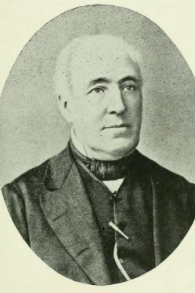
John Black was a Scottish merchant and politician in New Brunswick. He served as the representative for Northumberland County in the Legislative Assembly of New Brunswick from 1793 to 1795.

Nova Scotia is a Canadian province located in Canada's Maritimes. The region was initially occupied by Mi'kmaq. The colonial history of Nova Scotia includes the present-day Maritime Provinces and the northern part of Maine, all of which were at one time part of Nova Scotia. In 1763, Cape Breton Island and St. John's Island became part of Nova Scotia. In 1769, St. John's Island became a separate colony. Nova Scotia included present-day New Brunswick until that province was established in 1784. During the first 150 years of European settlement, the colony was primarily made up of Catholic Acadians, Maliseet, and Mi'kmaq. During the last 75 years of this time period, there were six colonial wars that took place in Nova Scotia. After agreeing to several peace treaties, the long period of warfare ended with the Halifax Treaties (1761) and two years later, when the British defeated the French in North America (1763). During those wars, the Acadians, Mi'kmaq and Maliseet from the region fought to protect the border of Acadia from New England. They fought the war on two fronts: the southern border of Acadia, which New France defined as the Kennebec River in southern Maine, and in Nova Scotia, which involved preventing New Englanders from taking the capital of Acadia, Port Royal and establishing themselves at Canso.

The Sebastopol Monument is a triumphal arch that is located in the Old Burial Ground, Halifax, Nova Scotia, Canada. The arch commemorates the Siege of Sevastopol (1854–1855), which is one of the last classic sieges of all time. This arch is the 4th oldest war monument in Canada (1860). It is the only monument to the Crimean War in North America. The arch and lion were built in 1860 by stone sculptor George Lang to commemorate British victory in the Crimean war and the Nova Scotians who had fought in the war.
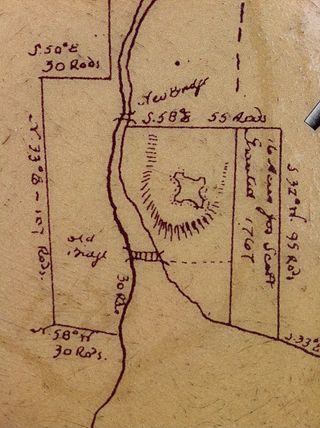
Fort Sackville was a British fort in present-day Bedford, Nova Scotia. It was built during Father Le Loutre's War by British adjacent to present-day Scott Manor House, on a hill overlooking the Sackville River to help prevent French, Acadian and Mi'kmaq attacks on Halifax. The fort consisted of a blockhouse, a guard house, a barracks that housed 50 soldiers, and outbuildings, all encompassed by a palisade. Not far from the fort was a rifle range. The fort was named after George Germain, 1st Viscount Sackville.

The North British Society was founded in Halifax, Nova Scotia in 1768, the oldest Scottish heritage society outside Great Britain. North British is an adjective used as an alternative to "Scottish".
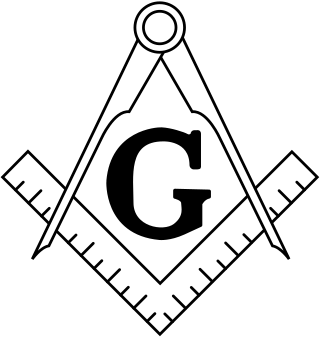
Freemasonry is a fraternal organisation that arose from the loose organization of medieval masons working in the medieval building industry.
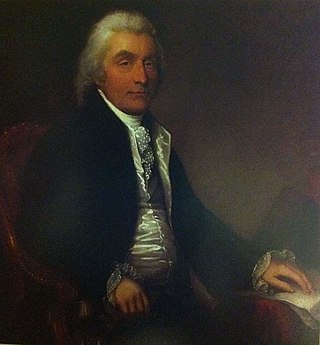
The Royal Nova Scotia Regiment was a battalion of infantry raised in 1793 to defend British interests in the colony of Nova Scotia during the Wars of the French Revolution. The unit was commanded by Colonel John Wentworth, the lieutenant-governor of the colony, throughout its existence. The Royal Nova Scotia Regiment (RNSR) had an undistinguished history through most of its existence, and saw very limited action, mostly in the role of marines, but did play an important role in the defense of Nova Scotia during these wars.
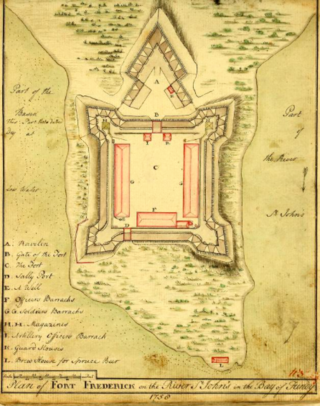
Fort Frederick was a British fort at what is now Saint John, New Brunswick, Canada. It was built during the St. John River Campaign of the French and Indian War. It was one of three significant forts which the British built on the major rivers in the Northeast to cut off the natives' water way to the ocean to prevent attacks on the British settlers.

John Halliburton (1725–1808) was a surgeon and a Loyalist who settled in Nova Scotia. He was a member of the North British Society. He is the father of Chief Justice Brenton Halliburton and, in turn, the grandfather of John C. Halliburton. He is buried in the Old Burying Ground. Halliburton was elected a Fellow of the American Academy of Arts and Sciences in 1797. He was a close friend of Dr. Duncan Clark and shared the responsibility for the medical care of the Duke of Kent. He built his home the Bower, that still stands in Halifax.

The Royal Navy Burying Ground is part of the Naval Museum of Halifax and was the Naval Hospital cemetery for the North America and West Indies Station at Halifax, Nova Scotia. It is the oldest military burial ground in Canada. The cemetery has grave markers to those who died while serving at Halifax and were treated at the Naval medical facility or died at sea. Often shipmates and officers had the grave markers erected to mark the deaths of the crew members who died while in the port of Halifax.
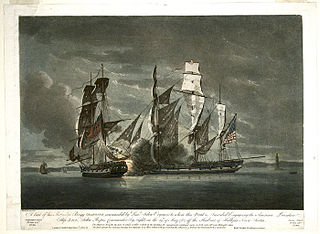
The Province of Nova Scotia was heavily involved in the American Revolutionary War (1776–1783). At that time, Nova Scotia also included present-day New Brunswick until that colony was created in 1784. The Revolution had a significant impact on shaping Nova Scotia, "almost the 14th American Colony". At the beginning, there was ambivalence in Nova Scotia over whether the colony should join the Americans in the war against Britain. Largely as a result of American privateer raids on Nova Scotia villages, as the war continued, the population of Nova Scotia solidified their support for the British. Nova Scotians were also influenced to remain loyal to Britain by the presence of British military units, judicial prosecution by the Nova Scotia Governors and the efforts of Reverend Henry Alline.




















